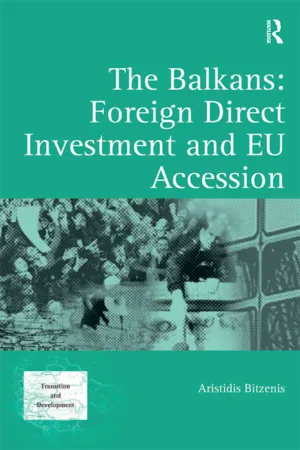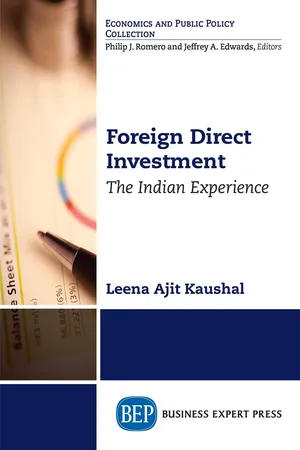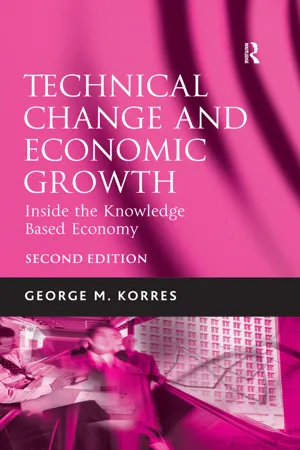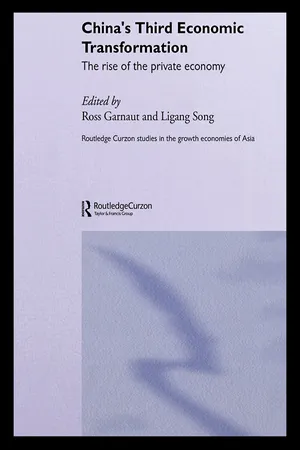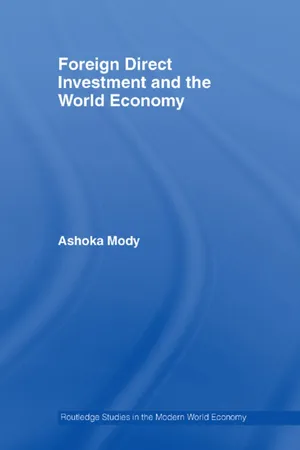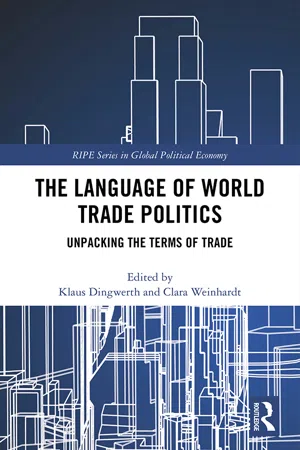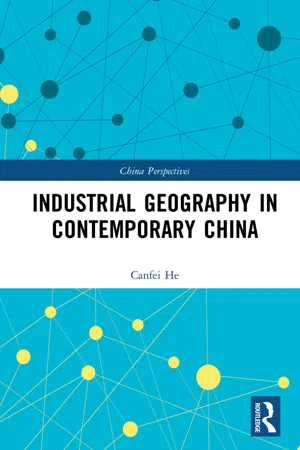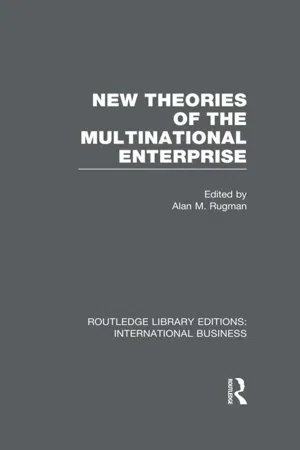Economics
Foreign Direct Investment
Foreign Direct Investment (FDI) refers to when a company or individual from one country invests in a business or entity located in another country. This investment involves a significant degree of control or influence by the investor over the operations of the foreign business. FDI is a key driver of globalization and can bring benefits such as job creation and technology transfer.
Written by Perlego with AI-assistance
Related key terms
Related key terms
1 of 4
Related key terms
1 of 3
10 Key excerpts on "Foreign Direct Investment"
- Aristidis Bitzenis(Author)
- 2016(Publication Date)
- Routledge(Publisher)
Each company has a different way of fully exploiting the potential of an investment besides the usual direct contact with the foreign country or the long-term involvement with foreign operations: (a) Offshore company: this is a method rather than a way of undertaking FDI. The parent firm creates the ‘offshore’ company in a country where certain aspects about the relationship between MNEs and the government, like taxation, are favourable, in order to undertake all FDI activities presenting as parent company the offshore company from a country with lower taxation rates. These countries are sometimes referred to as tax-heavens (e.g. Cyprus, Bermuda ($7.7 billion FDI outward stock), Cayman Islands ($20 billion FDI outward stock), and the Virgin Islands ($23.7 billion FDI outward stock)); (b) A Fade-out or planned divestment agreement may also be applied in all kinds of FDI agreements that involve a local partner. The agreement states that the foreign company agrees to liquidate the investment by selling its stakes after a certain period of time.3.1.1 Defining FDI
According to the Balance of Payment Manual (IMF, 1993),Direct investment is a category of international investment made by a resident entity in one economy [home country] (direct investor) with the objective of establishing a lasting interest in an enterprise resident in an economy [host country] other than that of the investor (direct investment enterprise). ‘Lasting interest’ implies the existence of a long-term relationship between the direct investor and the enterprise and a significant degree of influence by the direct investor on the management of the direct investment enterprise. Direct investment involves both the initial transaction between the two entities and all subsequent capital transactions between them and among affiliated enterprises, both incorporated and unincorporated.The IMF’s definition emphasizes ‘a lasting interest’, ‘a significant degree of influence’ of the investor over the company outside the home country (Brewer, 1994, 117). ‘FDI is defined as investment in equity to influence management operations in the partner company’ (Meyer, 1998, 125). ‘There are many different operational definitions of FDI, but all aim to encompass the desire of a home country firm to obtain and manage an asset in a host country’ (Barrell et al., 1997, 64). ‘A Foreign Direct Investment is the amount invested by residents of a country in a foreign enterprise over which they have effective control’ (Ragazzi, 1973, 471). Some definitions use ‘lasting interest’ and ‘significant amount of influence’ to define FDI. This is more accurate in explaining the current status of several FDIs, but it remains vague as it does not specify the target of the ‘influence’. ‘Influence management operations’ is more accurate, but again insufficient. In fact, in order to clarify this issue, one must first specify the amount of control the investing company needs over the company that receives the investment. This differs according to what the investing company expects from the investment.- eBook - ePub
Foreign Direct Investment
The Indian Experience
- Leena Ajit Kaushal(Author)
- 2019(Publication Date)
- Business Expert Press(Publisher)
Microeconomic FDI theories being firm-specific relate to ownership and internalization benefits and incline toward industrial economics and market imperfections. These theories examine FDI motivations from the investor’s viewpoint and connect with firm-level or industry-level perspective in decision making. FDI theories are reasonably complex to explain and apply. The chapter attempts to summaries different FDI theories, however; there is no generally accepted theory, and every new approach is adding certain new elements with criticism or improvement on the earlier one.Definitions of Foreign Direct InvestmentIMF defines FDI as a category of international investment where the resident entity in one economy being the direct investor obtains a lasting interest in an enterprise resident in another economy known as direct investment enterprise.1 The term “lasting interest” highlights the existence of a long-term relationship between the direct investor and the enterprise apart from the significant degree of influence in the management of the enterprise.India DefinitionFDI is characterized by a lasting interest which signifies the existence of a long term relationship and a significant degree of influence. In general, more than 10 percent ownership of the ordinary shares or voting power signifies this relationship. It includes both initial and subsequent transactions. According to the definition, FDI entails any foreign investment exceeding 10 percent limit through eligible instruments in an Indian listed company. However, all the existing foreign investments made under the FDI Route will be treated as FDI even if they are below the threshold limit.2 FDI also entails initial investments below 10 percent threshold which are later raised to 10 percent or beyond within one year from the date of the first purchase. The onus of rising to this level lies solely on the company, and if it does not touch 10 percent mark, then the investment shall be treated as portfolio investment. Nevertheless, if an existing FDI falls to a level below 10 percent, it will still be treated as FDI without an obligation to restore it to 10 percentage or more, as the original investment was an FDI. Foreign Investment in an unlisted company, irrespective of the threshold limit is considered as FDI. However, an investor can either hold the investments under the FPI route or the FDI route, but not both.3 - eBook - ePub
Technical Change and Economic Growth
Inside the Knowledge Based Economy
- George M. Korres(Author)
- 2016(Publication Date)
- Routledge(Publisher)
Direct investment is a category in which an international investment made by a resident entity in one economy (direct investor) with the objective of establishing a lasting interest in an enterprise (or, otherwise, the direct investment enterprise) resident in another economy is classified. Direct investment involves both the initial transaction between the entities and all subsequent capital transactions between them and among affiliated enterprises, both incorporated and unincorporated. OECD recommends that direct investment flows be defined as: “A foreign direct investor may be an individual, an incorporated or unincorporated public or private enterprise, a government, a group of related individuals, or a group of related incorporated and/or unincorporated enterprises which has a direct investment enterprise – that is, a subsidiary, associate or branch – operating in a country other than the country or countries of residence of the foreign direct investor or investors”. Moreover, following the IMF definition, we can say that: “Direct investment refers to investment that is made to acquire a stake in an enterprise operating in an economy other than that of the investor, the investor’s purpose being to have an effective voice in the management of the enterprise. The foreign entity or group of associate entities that makes the investment is termed the direct investor - eBook - ePub
- Ross Garnaut, Ligang Song(Authors)
- 2004(Publication Date)
- Routledge(Publisher)
8The impact of Foreign Direct Investment on China's economy
Chunlai Chen and Christopher Findlay
INTRODUCTION
The huge volume of Foreign Direct Investment (FDI) that has poured into China has been one of the most striking features of the country’s economic transition. The gradual liberalisation of restrictions on foreign investment since 1979 has greatly improved the investment environment. Foreign firms have been attracted by the huge domestic market and pool of relatively well-educated, low-cost labour. Extensive business connections with overseas Chinese in Asia and around the world have also played a role in China’s popularity as an investment destination. Since 1993 China has been the second largest recipient of FDI in the world and the largest recipient of FDI to developing countries, with cumulated inflows totalling US$266 billion by 1998 (SSB 1999).FDI is believed to play a major role in economic development in host countries by boosting capital formation, employment and the transfer of technology (Dunning 1993; Caves 1996). FDI increases competition in the domestic economy and aids economic restructuring. In China foreign firms are now an important component of the economy and are especially active in the private sector. What are the characteristics of FDI in China and what impact has foreign investment had on the economy? This chapter looks at the effect of FDI on domestic capital formation, industrial structure, employment, productivity and technology transfer, and international trade.THE IMPORTANCE OF FDI TO CHINA
Since the announcement of an open-door policy in December 1978, China has gradually integrated itself into the world economy. The door widened further after the mid-1980s, particularly in the 1990s, and capital flows expanded dramatically as a result. - eBook - ePub
- Ashoka Mody(Author)
- 2007(Publication Date)
- Routledge(Publisher)
1 Is FDI integrating the world economy?
Introduction
At first pass, the answer to the question posed in the title of this chapter is a resounding “yes.” Foreign Direct Investment—or FDI—has spread rapidly through the world economy in the past two decades. More countries and more sectors have come become part of the international FDI network. The high level and diverse forms of FDI represent an important force generating greater global economic integration.However, this is not a complete, nor even the right, conclusion since it is necessary to define the term “integration” more precisely. Markets for goods and assets are regarded as integrated when their prices across nations converge. More trade may be symptomatic of global links but price convergence is the true evidence of integration. When considering FDI, however, no easy market price is identifiable. The presumption is that the flow of FDI brings closer together the returns to capital and labor across nations. A test, therefore, of global integration through FDI is whether it acts to facilitate the process of per capita income convergence across the nations.There is good reason to put FDI to this somewhat severe test. FDI is thrice blessed. It brings scarce capital where capital is needed and productive. It stimulates the domestic market for corporate control and hence serves to discipline managers. It is the bearer of knowledge to enhance productivity, potentially to the levels of international best practice. - eBook - ePub
The Language of World Trade Politics
Unpacking the Terms of Trade
- Klaus Dingwerth, Clara Weinhardt, Klaus Dingwerth, Clara Weinhardt(Authors)
- 2018(Publication Date)
- Routledge(Publisher)
4 Foreign Direct Investment Lukas Linsi Due to the growing transnationalisation of production and wealth chains, trade and Foreign Direct Investment (FDI) activities have become intrinsically linked phenomena. 1 Recent estimates suggest that intra-firm transactions account for no less than one third of global trade flows (Maurer and Degain, 2010, p. 10), making FDI an influential determinant of global trading patterns. As a result, FDI statistics have become increasingly important pieces of information in trade negotiations as well as scholarly analyses and public debates about global trade. When being used in such contexts, FDI statistics are commonly interpreted as indicators of the volumes of capital going from one country to another to finance the establishment of new companies there. However, this corresponds to only a small part of what statisticians measure when they measure FDI. As a matter of fact, substantial shares of measured global FDI flows do not cross any physical border in a meaningful sense, nor are they directly associated with the creation of new factories (or jobs). In short, the conceptual gaps between common notions of FDI in economic discourses and the content inside the statistics that measure those transactions are pronounced. Simultaneously, statistical agencies’ ability to track capital flows between nation-states in a globally integrated system of off-shored finance is further complicated by daunting technical difficulties, which can lead to large measurement inaccuracies in these figures. And because not all statistical agencies handle these challenges in the same way, different agencies can be measuring different things when they measure ‘FDI’, limiting the degree to which these statistics can be compared across countries. Needless to say, the combination of these factors makes FDI statistics a problematic construct - eBook - ePub
- Sherif Seid(Author)
- 2018(Publication Date)
- Routledge(Publisher)
inter alia, the protection of domestic labour against the export of jobs abroad, adequate revenue from the repatriation of dividends earned by overseas subsidiaries of home-based parent companies, the promotion and protection of technological leads enjoyed by home based MNEs, access to raw materials in short supply in the home state, or the need for the equal and reciprocal treatment of inward and outward investment (Muchlinski, 1995: 103). With regard to host states, FDI that comes with new capital, technology, goods or services not normally found locally at equivalent or lower cost is generally encouraged. However, conditions may be imposed relating to level of investment and local ownership, performance requirements, import levels, technology and skills transfer, job levels, export levels or long-term investment strategy (Muchlinski, 1995: 104).Increasingly, the laws of host countries on FDI are taking the form of a code or a single piece of legislation that states the pertinent rules relating to FDI in the country.1 They specify the authority responsible for supervising investment, conditions of entry and the sectors open to FDI, the controls FDI is subjected to, remissibility of funds, performance requirements, incentives granted to investors, and the circumstances of the termination of foreign investment and other similar matters. Such codes typically apply to FDI alone, while foreign investors in other sectors must generally obey all relevant laws. The existence of a single code enables the foreign investor to acquaint itself with the laws on foreign investment of a country more easily. It is part of an attempt to communicate the certainty in the rule of law that was discussed as part of the arguments for “good governance” in state intervention discussed in the last Chapter.Many countries now have laws controlling FDI. Even countries which traditionally maintain an open policy towards FDI now impose restrictions on the flow and activities of FDI. Until recently, the US policy on FDI, for example, was driven by “the principle of neutrality”, that is, trying not to be biased either in favour of or against FDI (Graham and Krugman, 1991: 119). Accordingly, foreign firms had identical rights of establishment as domestic firms and, once established, foreign firms did not face greater burdens as a result of government action or policy than domestic firms, nor did they receive special privileges that domestic firms did not (national treatment) (Graham and Krugman, 1991: 120). There were, of course, some exceptions to the “principle of neutrality” which applied essentially to those industries subject to federal regulation (Graham and Krugman, 1991: 120).2 Since 1988, however, there has been a tendency to extend the Federal Government’s ability to restrict FDI in areas beyond the federally regulated industries. The Exon-Florio Amendment,3 - eBook - ePub
The State of China's State Capitalism
Evidence of Its Successes and Pitfalls
- Juann H. Hung, Yang Chen, Juann H. Hung, Yang Chen(Authors)
- 2018(Publication Date)
- Palgrave Macmillan(Publisher)
2015 ).2For example, see Wang (2009 ).3This last point is consistent with the observation by Forte and Moura (2013 ): host countries’ governments are responsible for obtaining positive effects of FDI on their countries’ economic growth by improving their legal system and market conditions.4 For example, Jadhav (2012) found empirical results showing that in BRICS economies, trade openness, rule of law and accountability were vital determinants of FDI.Passage contains an image
© The Author(s) 2018Begin AbstractThe State of China’s State Capitalism https://doi.org/10.1007/978-981-13-0983-0_11Juann H. Hung andYang Chen (eds.)11. The Role of the Exchange Rate in China’s Outward Foreign Direct Investment
End AbstractXinyun Ding 1 andNimesh Salike1(1) International Business School Suzhou, Xi’an Jiaotong-Liverpool University, Suzhou, China11.1 Introduction
China has been one of the prime home destinations for Foreign Direct Investment (FDI) over the past few decades. Starting in 2005/2006, China began to be earnest in making outward FDI as well, with its aggregate outward FDI reaching over USD 180 billion by 2016, which was over 12.6% of global outward FDI flows. That outward FDI was a mere USD 5.5 billion in 2004, started to pick up in 2005 and grew rapidly after 2010, with an annual average growth rate of 19% during 2010–2016 (Fig. 11.1 ).Fig. 11.1Chinese outward FDI flow, 1990–2016 (billion USD). (Source: UNCTAD , Division on Investment and Enterprise)Moreover, the structure of Chinese outward FDI has changed over the period, becoming more and more complex and diversified (The Economist 2014 ). China is prepared to become a net capital exporter (Financial Times 2014 ) and continues to accelerate the outward investment. It is evident from Fig. 11.2 that the margin between Chinese outward FDI and inward FDI over gross domestic product (GDP) has narrowed over the years, and inward FDI was surpassed by inward FDI in 2016.Fig. 11.2Ratio of Chinese outward FDI and inward FDI over GDP (1990–2016). (Source: UNCTAD - eBook - ePub
- Canfei He(Author)
- 2022(Publication Date)
- Routledge(Publisher)
First of all, FDIs have contributed dramatically to China’s economic development. Almost all previous studies have affirmed the effects of FDIs on China’s GDP growth. Although some scholars argued that multinationals only shift low value-added production processes to China, which trapped it in labour-intensive industrial development for a long time, China still needs to thank them for bringing advanced knowledge as well as new technology and skills to drive the industrial transformation. Meanwhile, FDIs were highly concentrated in the east coast in the early stage, which widened the gaps of regional economic development and resulted in a sloping pattern from east to west. Furthermore, as the pollution heaven hypothesis posits, companies that choose to physically invest in foreign countries tend to (re)locate to the countries with the lowest environmental standards or weakest enforcement. When China gradually raises the environmental standards, many multinationals will relocate to other countries, leaving pollutants and unemployment behind. This section will focus on the socio-economic impacts of FDI in three aspects: (1) economic growth and industrial transformation; (2) differences in regional economic development; and (3) social impacts. 9.5.1 Economic Growth and Industrial Transformation Spillover effects and innovation. The spillover effect is the prerequisite to analyzing FDI’s contribution to local economic growth, both in terms of quality and quantity, since FDI arrives with a package of technology, management skills, human capital, and financial capital. Many developing countries hope to stimulate local innovation through the spillover effects of FDI because they believe that technological innovation is the key driver boosting economic development. Technological spillover effects can be achieved by labour flow, demonstration, external competition, and learning (Ji et al., 2014). Cheung et al - Alan Rugman, Alan Rugman(Authors)
- 2013(Publication Date)
- Routledge(Publisher)
The relocation of labour-intensive production from rich, labour-short countries to poor, labour-plentiful countries under the auspices of MNCs is a clear example of FDI responding to macroeconomic forces. The development of natural resources by MNCs from rich countries is also macroeconomic. But the question is whether or not this facet of the theory of FDI is of sufficient importance to warrant an approach to the theory from the macroeconomic standpoint. To answer it in the most straightforward way requires an examination of the micro- and macroeconomic dimensions of the location-specific variables and to use the results to assess the contribution of the three models reviewed in the preceding sections. The creation of a foreign subsidiary requires the joint use of internationally mobile factors of production controlled by the MNE with immobile, co-operationg factors in the host country. Only if the host-country factors are sufficiently cheap relative to their source-country equivalents will FDI take place in a free-trade world. The sets of factor prices in the source and host countries are determined by macroeconomic forces including national resource endowments and tastes and the patterns of international trade (given absolute price levels in each currency and a market-clearing rate of exchange). This traditional version of international trade theory can usefully be extended to include product-specific national resources which are not necessarily available in both (or all) countries. Similarly, quantitative differences in factors of production can be introduced into trade theory provided known differences in their productivity allow different factors to be reconciled into equivalencies. 13 All of these forces are macroeconomic and clearly they affect those investments which rely on wide disparities in the prices of immobile factors of production
Index pages curate the most relevant extracts from our library of academic textbooks. They’ve been created using an in-house natural language model (NLM), each adding context and meaning to key research topics.
Explore more topic indexes
Explore more topic indexes
1 of 6
Explore more topic indexes
1 of 4
